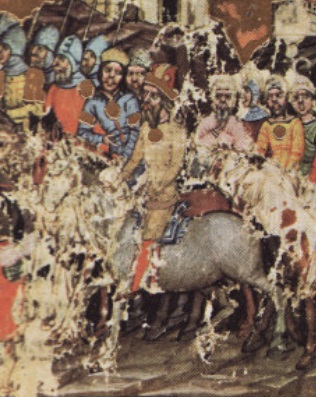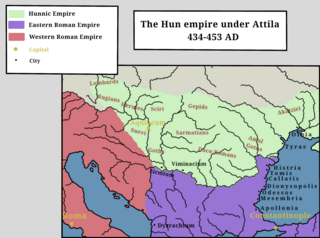Related Research Articles

The Huns were a nomadic people who lived in Central Asia, the Caucasus, and Eastern Europe between the 4th and 6th centuries AD. According to European tradition, they were first reported living east of the Volga River, in an area that was part of Scythia at the time. By 370 AD, the Huns had arrived on the Volga, causing the westwards movement of Goths and Alans. By 430, they had established a vast, but short-lived, empire on the Danubian frontier of the Roman empire in Europe. Either under Hunnic hegemony, or fleeing from it, several central and eastern European peoples established kingdoms in the region, including not only Goths and Alans, but also Vandals, Gepids, Heruli, Suebians and Rugians.

Bleda was a Hunnic ruler, the brother of Attila the Hun.

The Battle of Nedao was fought in Pannonia in 454 CE between the Huns and their former Germanic vassals. Nedao is believed to be a tributary of the Sava River.

Onegesius was a powerful Hunnic logades (minister) who supposedly held power second only to Attila the Hun. According to Priscus he "seated on a chair to the right of the king" i.e. Attila.

The Sciri, or Scirians, were a Germanic people. They are believed to have spoken an East Germanic language. Their name probably means "the pure ones".
Mundzuk was a Hunnic chieftain, brother of the Hunnic rulers Octar and Rugila, and father of Bleda and Attila by an unknown consort. Jordanes in Getica recounts "For this Attila was the son of Mundzucus, whose brothers were Octar and Ruas, who were supposed to have been kings before Attila, although not altogether of the same [territories] as he".

The Akatziri, Akatzirs or Acatiri were a tribe that lived north of the Black Sea, though the Crimean city of Cherson seemed to be under their control in the sixth century. Jordanes called them a mighty people, not agriculturalists but cattle-breeders and hunters. Their ethnicity is undetermined: the 5th-century historian Priscus describes them as ethnic Scythians, but they are also referred to as Huns. Their name has also been connected to the Agathyrsi. However, according to E. A. Thompson, any conjectured connection between the Agathyrsi and the Akatziri should be rejected outright.
Ernak was the last known ruler of the Huns, and the third son of Attila. After Attila's death in 453 AD, his Empire crumbled and its remains were ruled by his three sons, Ellac, Dengizich and Ernak. He succeeded his older brother Ellac in 454 AD, and probably ruled simultaneously over Huns in dual kingship with his brother Dengizich, but in separate divisions in separate lands.
Rugila or Ruga, was a ruler who was a major factor in the Huns' early victories over the Roman Empire. He served as an important forerunner with his brother Octar, with whom he initially ruled in dual kingship, possibly a geographical division where Rugila ruled over Eastern Huns while Octar over Western Huns, during the 5th century AD.

Uldin, also spelled Huldin is the first ruler of the Huns whose historicity is undisputed.

Ellac was the oldest son of Attila (434–453) and Kreka. After Attila's death in 453 AD, his empire crumbled, and its remains were ruled by his three sons, Ellac, Dengizich and Ernak. He ruled briefly and died at the Battle of Nedao in 454 AD. Ellac was succeeded by his brothers, Dengizich and Ernak.
Octar or Ouptaros was a Hunnic ruler. He ruled in dual kingship with his brother Rugila, possibly with a geographical division, ruling the Western Huns while his brother ruled the Eastern Huns.
By the name Edeko are considered three contemporaneous historical figures, whom many scholars identify as one:

Kreka or Hereka was the wife of Attila. She was described by Eastern Roman diplomat Priscus in his account of his stay at Attila's court in 448 or 449 AD. She and Attila had three sons: Ellac, Dengizich, and Ernak, who split among themselves what remained of Attila's empire after his death in 453.

Balamber was ostensibly a chieftain of the Huns, mentioned by Jordanes in his Getica. Jordanes simply called him "king of the Huns" and writes the story of Balamber crushing the tribes of the Ostrogoths in the 370s; somewhere between 370 and more probably 376 AD.
The Battle of Bolia, took place in 468 between the Ostrogoths and a coalition of Germanic tribes in the Roman province of Pannonia. It was fought on the south side of the Danube near its confluence with the river Bolia, in present-day Hungary. The Ostrogoths won, achieving supremacy in Pannonia, but soon migrated south towards richer lands.

The history of the Huns spans the time from before their first secure recorded appearance in Europe around 370 AD to after the disintegration of their empire around 469. The Huns likely entered Western Asia shortly before 370, from Central Asia: they first conquered the Goths and the Alans, pushing a number of tribes to seek refuge within the Roman Empire. In the following years, the Huns conquered most of the Germanic and Scythian tribes outside of the borders of the Roman Empire. They also launched invasions of both the Asian provinces of Rome and the Sasanian Empire in 375. Under Uldin, the first Hunnic ruler named in contemporary sources, the Huns launched a first unsuccessful large-scale raid into the Eastern Roman Empire in Europe in 408. From the 420s, the Huns were led by the brothers Octar and Ruga, who both cooperated with and threatened the Romans. Upon Ruga's death in 435, his nephews Bleda and Attila became the new rulers of the Huns, and launched a successful raid into the Eastern Roman Empire before making peace and securing an annual tribute and trading raids under the Treaty of Margus. Attila appears to have killed his brother, and became sole ruler of the Huns in 445. He would go on to rule for the next eight years, launching a devastating raid on the Eastern Roman Empire in 447, followed by an invasion of Gaul in 451. Attila is traditionally held to have been defeated in Gaul at the Battle of the Catalaunian Fields, however some scholars hold the battle to have been a draw or Hunnic victory. The following year, the Huns invaded Italy and encountered no serious resistance before turning back.
Chelchal was a Hun commander serving as lieutenant general under the Byzantine Empire.
Eskam was Hun living in 5th-century Pannonia, then under the Hunnic Empire. He was possibly a shaman. His daughter was one of the numerous wives of Attila the Hun.
References
- ↑ Maenchen-Helfen 1973, p. 86.
- 1 2 Pritsak 1982, p. 446.
- 1 2 Maenchen-Helfen 1973, p. 407.
- ↑ Maenchen-Helfen 1973, p. 144.
- ↑ Maenchen-Helfen 1973, p. 149.
- ↑ Maenchen-Helfen 1973, p. 156.
- ↑ Maenchen-Helfen 1973, p. 165–166, 187.
- 1 2 3 4 Maenchen-Helfen 1973, p. 166.
- ↑ Given 2015, p. 151.
- ↑ Given 2015, p. 151–152.
- 1 2 3 Given 2015, p. 152.
- ↑ Heather 2007, p. 356, 363.
- 1 2 Maenchen-Helfen 1973, p. 167–168.
- ↑ Given 2015, p. 152–153.
- ↑ Given 2015, p. 153–154.
- 1 2 3 Maenchen-Helfen 1973, p. 168.
- ↑ Maenchen-Helfen 1973, p. 163–164.